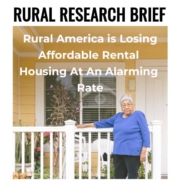HAC News Formats. pdf
August 10, 2016
Vol. 45, No. 15
• Additional $5.6 billion needed to preserve USDA rental housing • “Make Room” coalition launches campaign to end U.S. rental housing crisis • USDA launches online data and mapping • HUD issues new single-family property disposition regulations • Audit supplement issued for nonprofits and others • CDFI Fund seeks to shift incentives for Bank Enterprise Awards lenders • Mortgage servicing rules amended • Racial wealth divide is increasing, research finds • Veteran homelessness dropped by almost half since 2010 • Please nominate national or local rural housing leaders for HAC awards
HAC News Formats. pdf
August 10, 2016
Vol. 45, No. 15
Additional $5.6 billion needed to preserve USDA rental housing. The Comprehensive Property Assessment of the USDA Rural Development Multi-Family Housing Portfolio updates a 2004 assessment that covered Section 515 properties only. The new research, funded by USDA and conducted by consultants, also reviewed off-farm Section 514/516 farmworker housing properties, those with loans guaranteed under the Section 538 program, and those that have used the MPR preservation program. Researchers found that over the next 20 years, $5.6 billion will be needed, in addition to existing capital reserves, to cover capital costs. The report suggests USDA consider using available tools to reduce mortgage payments so property owners can put more money into capital reserves.
“Make Room” coalition launches campaign to end U.S. rental housing crisis. The partnership between Enterprise Community Partners, MacArthur Foundation, Ford Foundation, CohnReznick LLP, and others including HAC hopes to elevate rental housing on the national policy agenda. Make Room’s website offers information about rental affordability and suggestions for action by individuals and organizations.
USDA launches online data and mapping. Information about individual properties receiving loans, loan guarantees, and grants through RHS single-family housing, multifamily housing, and community facilities programs is now available online through a partnership with PolicyMap. Demographics, income levels, affordability, and more can be mapped. Data is also posted on USDA’s site. More data related to rental preservation is expected to become available.
HUD issues new single-family property disposition regulations. The rule governs sales of FHA homes to individuals, government entities, and nonprofits. Contact Thomas Kumi, HUD, 202-708-1672.
Audit supplement issued for nonprofits and others. OMB’s 2016 Supplement applies to 2 CFR Part 200, the regulation that replaced OMB Circulars including A-133, and applies to audits of nonprofits and state, local, and tribal governments that receive federal funding. Comments are due October 31. For more information, contact the federal agency that awarded or oversees the funding being audited.
CDFI Fund seeks to shift incentives for Bank Enterprise Awards lenders. When reviewing BEA participants’ activities in distressed communities, the CDFI Fund will look separately at consumer loans (which include loans for affordable housing purchase and home improvement) and at commercial loans and investments (which include loans for affordable housing development). Comments are due October 11. Contact Robert Ibanez, CDFI Fund.
Mortgage servicing rules amended. The Consumer Financial Protection Bureau released a lengthy final rule amending mortgage servicing rules it issued in 2013. A CFPB blog post says the changes are intended to improve communication and availability of loss mitigation for homeowners, add protections for those who obtain property through death or divorce, and require information for those in bankruptcy proceedings. Contact CFPB’s Office of Regulations, 202-435-7700.
Racial wealth divide is increasing, research finds. The Ever-Growing Gap, released by CFED and the Institute for Policy Studies, reports that from 1983 to 2013, the average black family’s wealth grew by a little less than $20,000, Latino families’ increased by about $40,000, and white families’ wealth went up more than $300,000. If current trends persist, by 2043, when people of color are predicted to outnumber white people for the first time in the U.S., the racial wealth gap will double, leaving the average white family with over $1 million more in assets than black and Latino families. Recommendations include identifying government policies that contribute to the discrepancy, changing tax incentives, and addressing the growing concentration of wealth at the top.
Veteran homelessness dropped by almost half since 2010. Data released by HUD, VA, and the U.S. Interagency Council on Homelessness show a 17% decrease between January 2015 and January 2016, and a 47% drop since 2010. Nationwide, fewer than 40,000 veterans were experiencing homelessness on a given night in January 2016. Estimates for each state and Continuum of Care are online. Veterans who are homeless or at imminent risk of becoming homeless can speak to a homeless coordinator at a VA Medical Center or call 1-877-4AID-VET.
Please nominate national or local rural housing leaders for HAC awards! Nominations are due September 30 for the Cochran/Collings Award for national rural housing service and the Skip Jason Community Service Award. The honors will be presented at HAC’s Rural Housing Conference, November 29-December 2. Complete the online nomination form on HAC’s website. Questions? Contact Lilla Sutton, HAC, 202-842-8600.

 Housing Assistance Council
Housing Assistance Council